Vertical farming and cannabis
List of contents
When growing cannabis indoors, the classic approach is to grow horizontally (or flatbed), generally using square or rectangular trays (depending on the shape and size of the grow tent or room), with the pots containing the plants placed side by side. Horizontally, one grow light is normally used to illuminate each square metre; and the plants are usually arranged in a “stadium shape” to take better advantage of the light: with the shortest plants placed in the centre and the highest around the sides.
However, every experienced grower knows that the maximum light output is still not always achieved and that many plants do not receive the amount of light they should. For this reason, vertical cultivation is an excellent tool for those who want to make the most of their resources indoors. Because vertical growth, when done correctly, can increase yields and maximise efficiency.
In many ways, it is a game-changer as the boundaries of innovation are being pushed upward. Vertical growing techniques provide opportunities that are unimaginable with traditional horizontal cultivation, particularly in more mature markets such as the USA, where commercial cannabis growers seek to improve yields, reduce costs and maximise space.
Vertical farming: less is more
The vertical cultivation technique is the practice of growing plants in vertically stacked layers or sloping surfaces; It consists of placing the cannabis plants on shelves, walls, or in columns, with the light source placed in the centre or on each individual shelf layer. In this way, it is possible to take better advantage of the space and ensure that more light reaches all the plants, thus achieving a higher yield. It's all about maximising harvests while using the minimum available space.

It's worth remembering that this method can be a real challenge for those who are starting indoor cannabis cultivation because when growing indoors we need to control so many more variables than in outdoor cultivation. For this reason, it is not advisable to start a vertical cultivation system until the basic concepts such as the control of temperature, pH, or EC have been mastered. Aside from this, vertical growing systems can be used with almost any type of indoor cultivation method, from hydroponics and aeroponics to organic substrates, although the latter option offers the least functionality.
If you already have some experience in this field, you may want to consider making the leap to this form of cultivation, as when it is done properly, it can considerably increase the total amount of buds harvested and save you a lot of space at the same time.
Vertical cultivation has not yet revolutionised the cannabis industry, but it is focused on supplying a high-demand market. In that climate, the future of cannabis could be in upward growth.
How does vertical cultivation work with cannabis?
There are several ways to grow cannabis with this system, some are easier for those who are just starting out while others require a higher level of experience and investment.
Staggered stacked vertical cultivation
This system consists of placing the plants on staggered shelves creating a square or hexagon that takes the shape of a coliseum. The idea is to have a central light source that illuminates the entire interior of the system in 360 degrees. In this way, you can use much more space (from floor to ceiling), and increase the number of plants per light source.
This system can be assembled at home but requires certain skills and prior design. If you decide to do so, we recommend you to bear in mind that sometimes it is useful to make the shelves incline inwards slightly, so that in this way the plants grow towards the centre and receive more light, while saving space.
If you do not want to venture into DIY work, there are also manufacturers that produce structures designed for this purpose. Although they are considerably more expensive than a conventional grow tent, if well used, they pay off in the long run.
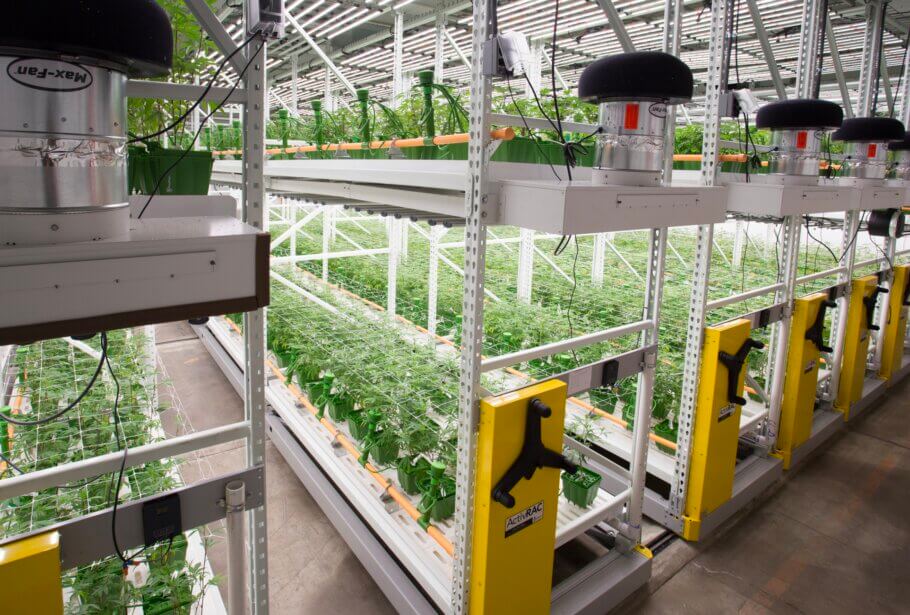
Vertical crop stacked on flat shelves
This is the most common vertical growing method for large cash crops: tiered plant shelves with LED grow lights above each shelf. The plants are pruned and defoliated to keep them short. Growers even stack layers of plants in the flowering stage, although the plants are larger and with heavy main buds.
A variant of this system is vertical cultivation with mobile racks, where the shelves can be moved horizontally using rollers and rails, as if they were the shelves of an archive or library collection, saving even more space.
Vertical column farming
Growing vertically with this method takes the technique to another level. In reality, the cost of the necessary technology is so high that, unless it is grown on a medium or large scale for commercial purposes, it is not worth the investment. For example, wall-mounted systems make use of pre-fabricated wall frames or the walls of a room to hold hanging grow systems, where the grow pots rotate to the sides.
This system allows for the plants to be placed in openings within the columns, inside which the nutrient solution flows via a sophisticated hydroponic and sometimes aeroponic system. Vertical growing in columns or living walls can be applied to cannabis as well as other plants and, for this reason, it is sometimes used to decorate hotel rooms or other facilities because the visual effect is truly fascinating.
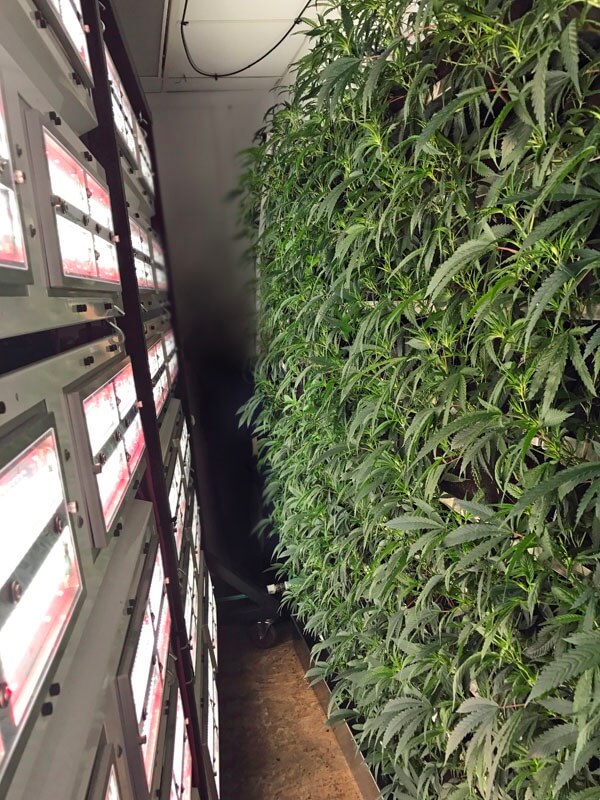
Plants can also be placed in a cylindrical arrangement to better exploit the location of the central light and increase the total absorption of photons, especially in large-format crops. In cylindrical systems, the plants are placed in pots arranged in a mesh that is held in place by rows of plastic, inclined slightly towards the central light channel. Behind the pots is a thick wall that can hold foggers or irrigation tubes for drip lines.
How to water the plants with a vertical farming system?
As you may be imagining, hand watering a vertical crop can be awkward, to say the least. For this reason, the irrigation is usually done automatically and using hydroponic systems (the pots weigh less and take up less space). Not all hydroponic solutions are suitable for all types of vertical crops, but the concept is based on removing soil from the equation and providing the plant's root system with direct access to a water-based nutrient mix. The water resources are effectively directed to the plants and then recycled back to the system for reuse.
This system rules out the possibility of growing with organic fertilisers, since no companies offer this type of product for hydroponics, as they would spoil if they were in the irrigation tank for more than 24 hours. Therefore, if you want to grow cannabis vertically, you must consider the fact that you will be using mineral fertilisers, and therefore, the final quality of the buds will not be the same as with organic ones.
The fact that the irrigation is automatic does not imply that you can ignore it completely. If you decide to use drip irrigation, for example, it is important that you regularly check that the drippers are not clogged throughout the cycle.
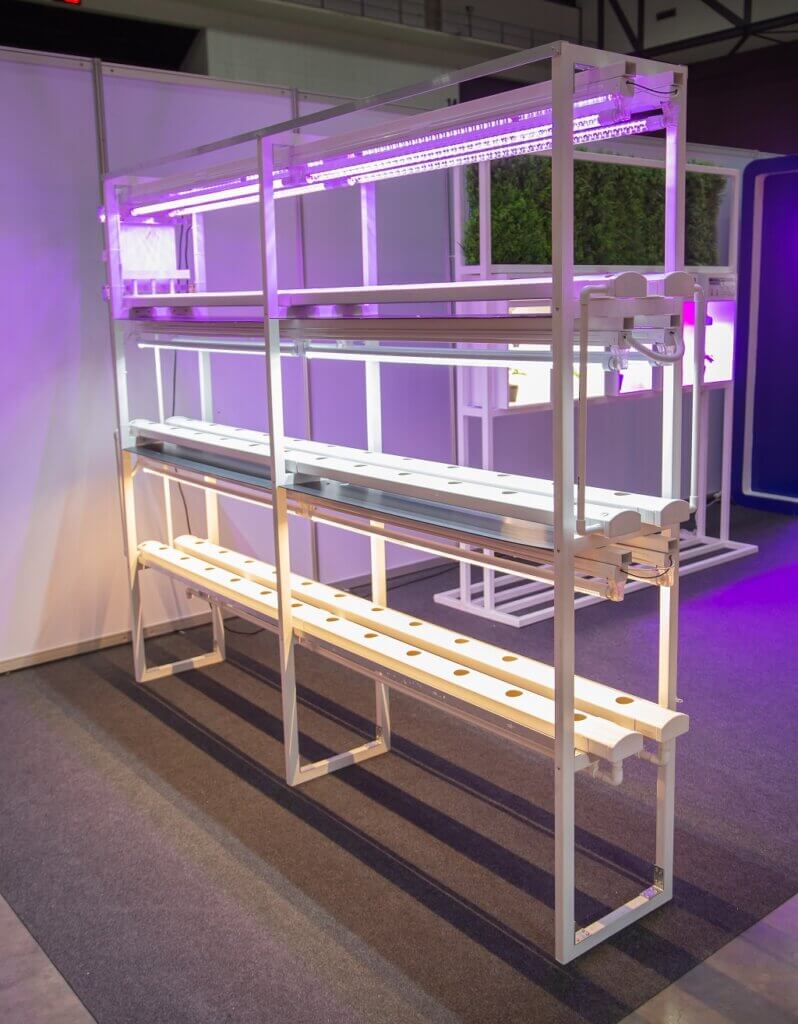
Advantages and disadvantages of vertical cannabis farming
Like all cultivation methods, vertical growing has its strengths and weaknesses. The best thing is for each cannabis grower to make their decisions based on their own needs and circumstances. Here are some of the pros and cons of growing cannabis vertically to help you make your mind up:
Advantages of vertical cannabis farming
- Greater efficiency: it can increase crop productivity by approximately 30%, with lower electricity costs using the same space as well as lower water consumption: Depending on the specific crop and configuration, a vertical design can achieve 70 to 90 per cent water efficiency over horizontal crops.
- More cycles per year: the increase in yield occurs not only because the quantity of buds in each harvest is greater, but also because it means that more crops can be grown per year. The reason is that this technique is usually based on growing many smaller plants; Therefore, it is not necessary to extend the vegetative period for long, significantly reducing the total cultivation time.
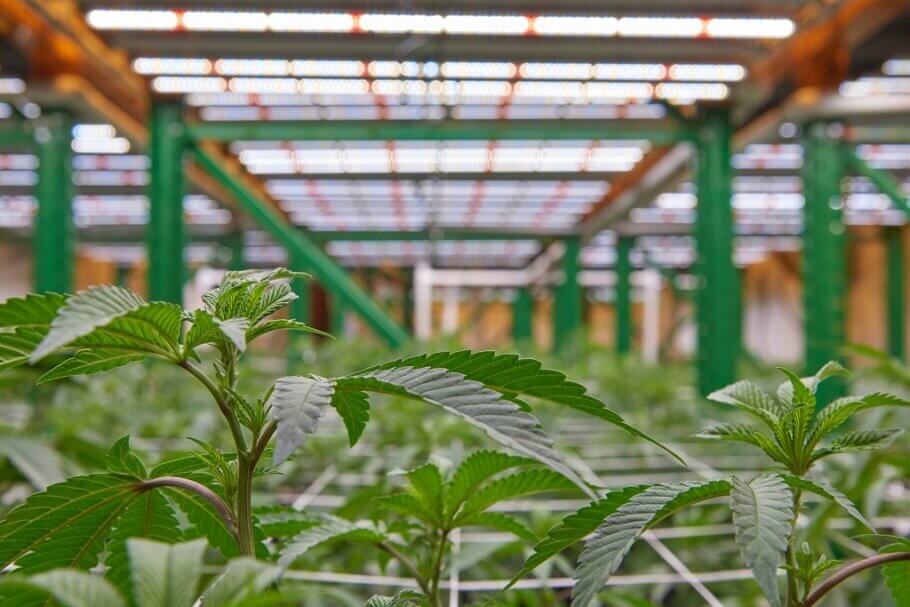
Disadvantages of vertical cannabis cultivation
- Higher initial cost: unless you are a handyman and are able to build your vertical grow economically, the structures and equipment necessary to apply this technique require a larger initial investment. In fact, stacked systems can increase production costs due to the duplication of equipment and resources required for each level of cultivation.
- High level of complexity: as we explained before, this method is not recommended if you are new to growing indoor cannabis. You must bear in mind that maintaining homogeneous environmental conditions vertically and in such a dense space is more complicated than in a horizontal situation and that advanced climate control systems are required to preserve the quality of the plants. And that certain maintenance tasks, such as carefully controlling the height of the plants or ensuring that the irrigation system works correctly, are logistically complicated.
- Increased stress to plants: Keeping the lamp distance constant from the plant canopy, as with traditional pendant light crops that can be adjusted in height, provides a more natural and stable growing environment, a benefit that often it is lost in vertical cropping systems. In vertical systems with stationary light systems, the distance from the lamp to the plant inevitably changes as the plant grows and changes shape. This can cause problems in the physiological development and biorhythm of a plant.
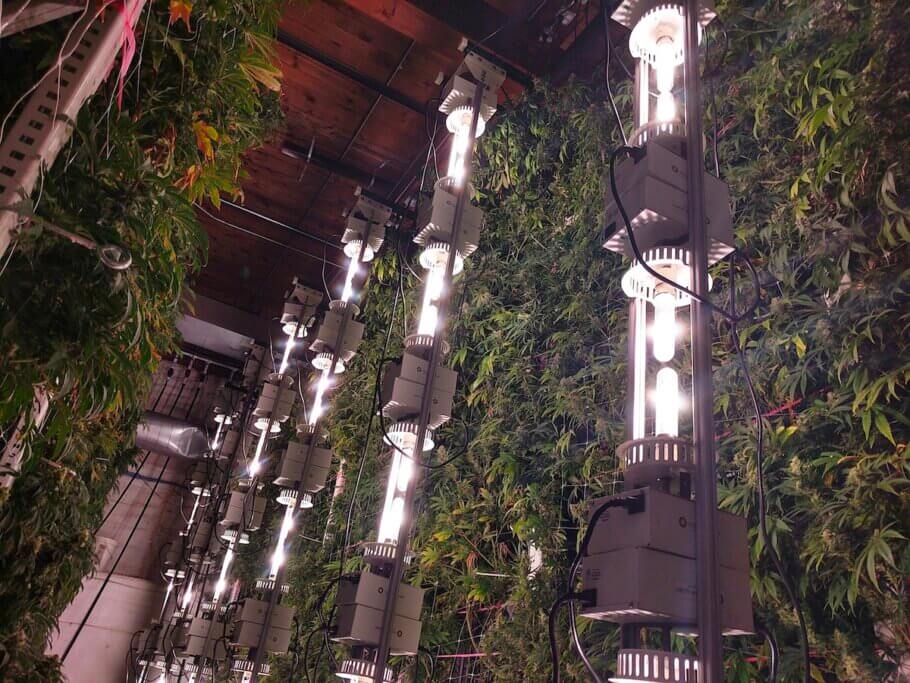
What should you take into account when setting up your own vertical grow?
A successful vertical crop requires preparation and, above all, being well informed. Here are a series of tips that will be useful if you are thinking of getting started with this technique:
- Design your vertical grow in advance: this rule applies to any crop, especially if it is going to be done indoors. A little planning when it comes to understanding how the space will work is necessary to prevent future mistakes and difficulties. Evaluate factors such as distribution (making a sketch will help you), temperature control, ventilation, irrigation, access to all plants, etc.
- Choose the variety you are going to grow wisely: due to the peculiarities of vertical cultivation, many growers opt for indica genetics that are smaller in size, because the worst thing that can happen is to have monsters that grow too large. In addition, the SOG (Sea Of Green) technique is one of the most used vertically, only instead of a "sea", you will have many "ponds" of green. If you opt for this, you should choose strains that produce large central colas and do not develop too much lateral branching.
- Choose the correct lighting system: ideally, for a vertical grow you should use LEDs. In fact, the main catalyst behind growing cannabis vertically has been the improved performance of LED lighting. The reason is that with this system the plants should be closer to the light than in a horizontal grow (if you really want to do it efficiently). Therefore, HPS lamps are not a good option as they emit too much heat and can burn the plants. There are those who use a cool tube to alleviate this problem, but our recommendation is once again to use LED technology, as it is more efficient and provides better options in terms of light spectrum. Although it is true that this type of lighting is more expensive in the beginning, it also produces the same light output as sodium lamps at a much lower cost, so you will save on your electricity bill and in the long run, you will recover the initial investment.
If we are sincere, vertical farming can be a great resource to supply the demand of a large mass of consumers in constant growth and in expanding markets, such as in North America, by using indoor growing more efficiently for crops that save space and resources. However, on a home-growing scale, it's not a technique for the faint of heart: it takes commitment, passion, and skill. And above all technology, because this method of production represents a change of pace for many growers. But fortunately, there is more and more automation and quality equipment on the market that make these systems easier to use.
Happy growing!

































































